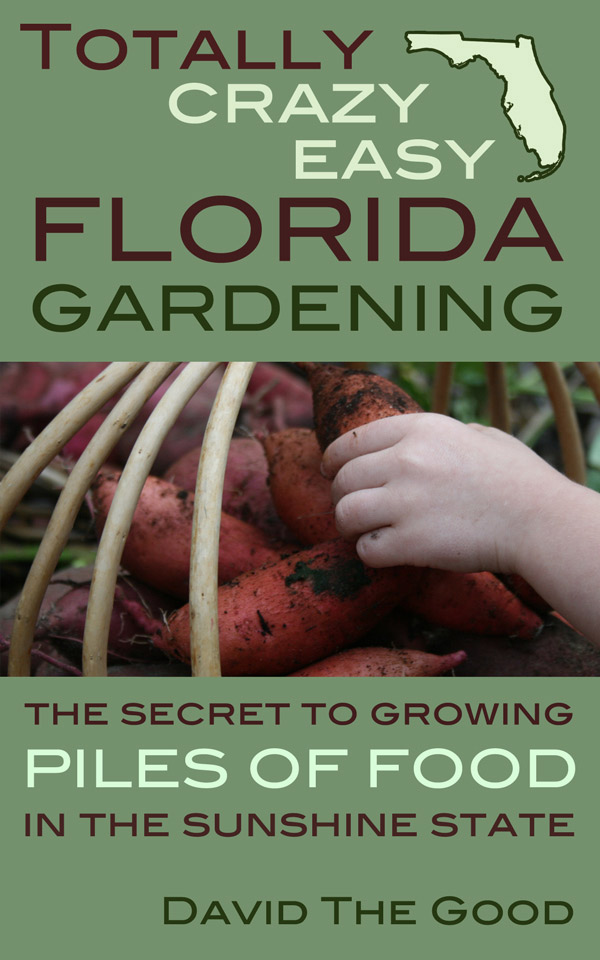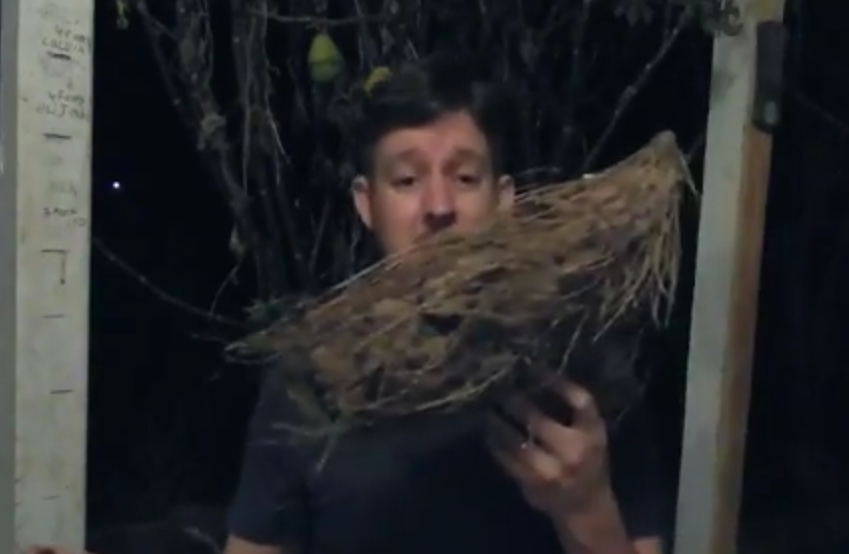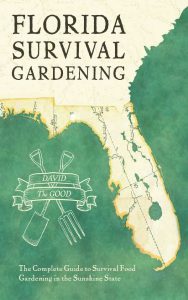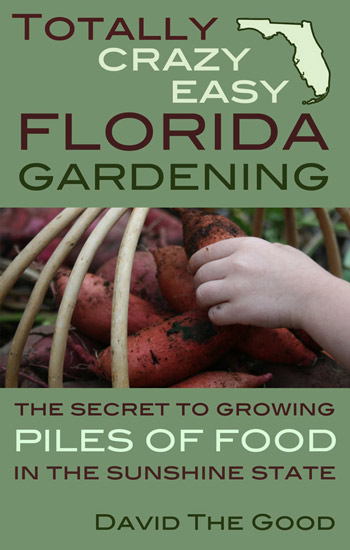I posted a new video yesterday giving you the secret to easy Florida gardening – check it out:
Transcription:
I grew almost a thousand lbs of food in my Florida garden in 2015.
 I wrote a book called Totally Crazy Easy Florida Gardening: The Secret To Growing Piles of Food in the Sunshine State.
I wrote a book called Totally Crazy Easy Florida Gardening: The Secret To Growing Piles of Food in the Sunshine State.
Here’s the main part of the secret:
The secret is growing the plants that grow in Florida.
If you grow the plants that thrive in Florida you can grow more food with less work than you ever thought possible.
Here’s the thing with Florida, right: people move down here to Florida and they try to grow a bunch of Yankee plants, and they try to grow them the way they read in garden books that were written for a Northern audience, or they were written in the perfect South California environment or, you know, someplace in Oregon and you go… “nothing works! I tried putting in a raised bed with a lot of compost and it didn’t work very well, I tried growing tomatoes and then they all rotted and they got holes drilled in them by stinkbugs, and everything got wrecked!”
Well, here’s the thing: Florida is a very unique climate. Where I am in Florida we get freezes in the winter, and they’ll take out the tropical plants. We get like 10-12 freezes maybe in a winter that wrecks the tropical stuff. So you think, “hey I can grow papayas,” and then papayas grow really well until December when you get the first freeze and the papaya plant melts. So that’s not quite right. Try to grow cabbages, you plant them in March, and then it gets to April and it gets really hot and dry and they just fall to pieces and they look bad and by May you have a bunch of lousy cabbages.
With Florida, you’ve got to grow the plants that grow well in Florida
For the last 5 or 6 years I’ve tested plants that have comparable climates. Places like the Mediterranean, where they get some frosts sometimes but they have long, hot summers. Or Africa. Or Southeast Asia. And some of these plants you’re not familiar with, and I cover a lot of these plants in the book. Plants like the yard-long bean or the asparagus bean from Southeast Asia. It grows like a weed. You can plant it in the middle of the summer and it’ll still produce and it makes these beans that are like (this long). They’re not quite a yard so it’s false advertising, but they’re close. They’re close to a yard long. I grow chaya, which is Mexican tree spinach which comes from Mexico. And it’s a perennial green that is healthier for you than regular spinach. You boil it for ten minutes and you cook it and it’s a great, chewy, delicious, nutrient-rich cooked green. I grow plants like Surinam purslane which hardly anybody has heard of. It’s Talinum fruticosum. Nice, crunchy, delicious, watery leaves that are very good.
Grow the kind of stuff that will grow here. Grow yams, right? I’m not talking sweet potatoes – I’m talking African yams.
Oh, just a second.
Like this.

This is a lot of root. This is like a huge Idaho potato.
You know how much work it took to grow that thing?
It took me about 10 seconds to plant it and then it took me maybe an hour to dig it up two years later. It’s a perennial vine. And so, you can just grow the stuff that actually grows here and you can eat really good food, but you have to nail down the plants that grow well here. If you try to grow beefsteak tomatoes you’re gonna fight with it, but if you grow Everglades cherry tomato which is probably a native Florida variety – that thing grows like crazy and it will pop up year after year, it’ll self-seed and come back and you get all these amazing sweet little cherry tomatoes, and they grow great!
Some of these plants that you would grow up north, if you planted your cabbages in March, you know, they’re not gonna do well. If you plant them in early February, they’re gonna do fine. If you planted them in November they do fine. It doesn’t usually freeze hard enough to hurt any cabbages, so you can have them growing through the winter and then they pop into their growth and they make great big nice heads in March and April and they’re ready to go.
So you’ve gotta learn the plants that grow in Florida and then grow those. You don’t have to have containers, you don’t have to have perfect soil, you don’t have to do expensive raised beds. You can plant these plants and with a minimum amount of work get a lot of food, but you’ve got to pay attention to the climate and you’re going to have to adjust your eating a little bit to get used to the stuff that grows here. Some of the stuff from up north grows great but you’ve got to grow it in the winter. Some of the stuff from further south grows great but you’ve got to grow it in the summer because it’s going to freeze in the winter.
Once you learn those plants: I did very little work for that 1000lbs of food.
I did a few hours here and there in the spring, then a few hours of harvesting, a few hours here and there in the fall getting stuff in for the fall gardens, and they grow like crazy and I don’t do aquaponics and all kinds of complicated systems and gutter gardens and MiracleGro and all that kind of stuff.
I grow with compost on my own property, some organic amendments here and there and then I get lots and lots of food, because I grow the plants that grow well in Florida.
So that’s the secret to Florida gardening: figuring out what grows here and then growing that. It’s really not all that hard.
Try it  out, test some of these crops, look it up, I’ve got a huge crop list in the book with a ton of stuff that grows well and I’ve got it ranked according to how easy they are. Check that out and do it. You can find the book on Amazon, and you can also find lots of information – I’ve got over 1,000 posts at my website TheSurvivalGardener.com a lot of which is geared towards Florida, though I’ve started to move more towards international crops as well, so hunt me down at TheSurvivalGardener.com, find my books on Amazon, be sure to like and share the videos, and you can grow 1000lbs of food without a lot of work. And I could have done triple that if I had really, really worked at it and just planted more space. Just a matter of putting it in and doing it. But we were able to grow all the vegetables we needed with the exception of a few roots and it was all organic and we ate very well.
out, test some of these crops, look it up, I’ve got a huge crop list in the book with a ton of stuff that grows well and I’ve got it ranked according to how easy they are. Check that out and do it. You can find the book on Amazon, and you can also find lots of information – I’ve got over 1,000 posts at my website TheSurvivalGardener.com a lot of which is geared towards Florida, though I’ve started to move more towards international crops as well, so hunt me down at TheSurvivalGardener.com, find my books on Amazon, be sure to like and share the videos, and you can grow 1000lbs of food without a lot of work. And I could have done triple that if I had really, really worked at it and just planted more space. Just a matter of putting it in and doing it. But we were able to grow all the vegetables we needed with the exception of a few roots and it was all organic and we ate very well.
So that’s my two cents – that’s the secret!


2 comments
This was commen spence yet so eye opening. Thank you for your knowledge and tips. They have opened my eyes to things now.
You bet – thank you, Tori.
Comments are closed.